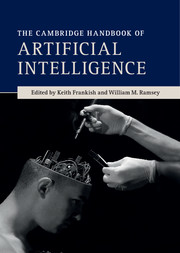Book contents
- Frontmatter
- Contents
- List of figures
- Notes on contributors
- Acknowledgments
- Introduction
- Part I Foundations
- Part II Architectures
- Part III Dimensions
- 7 Learning
- 8 Perception and computer vision
- 9 Reasoning and decision making
- 10 Language and communication
- 11 Actions and agents
- 12 Artificial emotions and machine consciousness
- Part IV Extensions
- Glossary
- Index
- References
7 - Learning
Published online by Cambridge University Press: 05 July 2014
- Frontmatter
- Contents
- List of figures
- Notes on contributors
- Acknowledgments
- Introduction
- Part I Foundations
- Part II Architectures
- Part III Dimensions
- 7 Learning
- 8 Perception and computer vision
- 9 Reasoning and decision making
- 10 Language and communication
- 11 Actions and agents
- 12 Artificial emotions and machine consciousness
- Part IV Extensions
- Glossary
- Index
- References
Summary
Introduction
Learning by artificial intelligence systems – what I will typically call machine learning – has a distinguished history, and the field has experienced something of a renaissance in the past twenty years. Machine learning consists principally of a diverse set of algorithms and techniques that have been applied to problems in a wide range of domains. Any overview of the methods and applications will inevitably be incomplete, at least at the level of specific algorithms and techniques. There are many excellent introductions to the formal and statistical details of machine learning algorithms and techniques available elsewhere (e.g., Bishop 1995; Mitchell 1997; Duda, Hart, and Stork 2000; Hastie, Tibshirani, and Friedman 2001; Koller and Friedman 2009). The present chapter focuses on machine learning as a general way of “thinking about the world,” and provides a high-level characterization of the major goals of machine learning. There are a number of philosophical concerns that have been raised about machine learning, but upon closer examination, it is not always clear whether the objections really speak against machine learning specifically. Many seem rather to be directed towards machine learning as a particular instantiation of some more general phenomenon or process. One of the general morals of this chapter is that machine learning is, in many ways, less unusual or peculiar than is sometimes thought.
Keywords
Information
- Type
- Chapter
- Information
- The Cambridge Handbook of Artificial Intelligence , pp. 151 - 167Publisher: Cambridge University PressPrint publication year: 2014
References
Accessibility standard: Unknown
Why this information is here
This section outlines the accessibility features of this content - including support for screen readers, full keyboard navigation and high-contrast display options. This may not be relevant for you.Accessibility Information
- 4
- Cited by
